- 1School of Science, Zhejiang Sci-Tech University, Hangzhou, China
- 2Key Laboratory of Optical Field Manipulation of Zhejiang Province, Zhejiang Sci-Tech University, Hangzhou, China
In this study, we investigated the properties of entanglement of an optomechanical system including two mechanical oscillators, where two mechanical oscillators are coupled with the cavity field in different coupling modes: the interaction between one mechanical oscillator and cavity field is first-order coupling, and the interaction between the other and the cavity field is quadratic coupling. On the one hand, the entanglement between two mechanical oscillators is studied. The influence of the frequency of the cavity field, the mass of mechanical oscillators, and the temperature of mechanical oscillators on the entanglement between two mechanical oscillators are investigated. On the other hand, for the given parameters of the system, we also obtained the entanglement between the cavity field and the mechanical oscillator that has a quadratic coupling. Compared with the entanglement between microscopic particles, the stable macroscopic quantum entanglement between two mechanical oscillators has the characteristics of long existence life and can be reused, and it also plays an important role in quantum information processing and quantum network construction.
1 Introduction
As an important resource of quantum information processing, quantum entanglement has always been a research hotspot in the field of quantum physics. In recent decades, researchers have obtained quantum entanglement in different physical systems [1–5], such as atomic system, ion trap system, and photon system. People use quantum entanglement to realize quantum teleportation [6], quantum dense coding [7], quantum remote state preparation [8], and construction of quantum logic gate [9]. These applications fully show the importance of quantum entanglement in the process of quantum information processing. In addition, quantum entanglement can also explore the basic physical problems in quantum mechanics, such as implicit variable theory and quantum non-locality [10, 11]. In recent years, a new physical system, that is, a cavity optomechanical system [12], has emerged in the field of the research of quantum information processing. The cavity optomechanical system can effectively couple the degree of freedom of photon with the degree of freedom of the mechanical oscillator, which can bring many novel physical phenomena [13–15]. People can use the cavity optomechanical system to perform quantum precision measurement [16], and they can couple the atomic system [17] or quantum dot system [18] with a cavity optomechanical system to realize coupling of more degree of freedom. In the coupling system with multi-degree of freedom, researchers can obtain the quantum nonlinear phenomena such as optomechanical induced transparency [19] and optical bistability [20].
At present, the manipulation of cavity optomechanics has become a kind of quantum control technology, which has been widely extended and applied. Vitali and his coworkers from Italy realized the entanglement of the cavity field and mechanical oscillator in the cavity optomechanical system [21]. This research team also proposed the coupling among the optical cavity, moving cavity mirror, and microwave cavity, and entangled the optical cavity mode and microwave cavity mode with the help of a mechanical oscillator [22]. For further research, they extended to the multi-degree of the freedom coupling system [23], and realized the entanglement among atom, moving mirror, and cavity field by coupling the cavity field with atom and mechanical oscillator at the same time. It is reported in nature that the stable quantum entanglement between two mechanical oscillators is realized by using this coupling [24]. The experimental realization of this macroscopic superposition state and macroscopic quantum entanglement state has become a new important milestone in the field of quantum physics. Since we know that the quantum entanglement of this macroscopic steady-state system has the characteristics of a long lifetime and can be reused, this plays an important role in quantum information processing and quantum network construction.
In this study, we consider an optical cavity containing the two mechanical oscillators, where the two mechanical oscillators are in cases of linear and quadratic coupling, respectively. When the cavity is driven by a laser, we investigate the properties of entanglement of the system. For the multibody system, the values of the logarithmic negativity can determine whether the system has entanglement. By calculating the logarithmic negativity, we analyze the possibility of entanglement between two oscillators in different cases where we choose different cavity frequencies and different masses of oscillators. Compared with the existing reported works, we also studied the entanglement between a single oscillator and cavity field. The remainder of this study is organized as follows. In Section 2, we show the theoretical model of a dual-coupling optomechanical system where the two mechanical oscillators are coupled with the cavity field in different coupling modes. In Section 3, some numerical results are shown, and we discuss the possibility of entanglement for different physical parameters. Finally, the results are summarized in Section 4.
2 Theoretical Model
Here, we consider a Fabry–Pérot optical cavity in Figure 1, which is composed of two parallel mirrors separated by a certain distance. The reflectivity of the mirrors is nearly unity. The reflectivity of the left mirror is slightly lower than that of the right mirror whose reflectivity is one, so the light is emitted from the left. The stable standing wave can be produced in the optical cavity when we use an incident light field to drive the optical cavity. For the standing wave, its energy is not static but flowing periodically to and fro between wave antinode and wave node. Moreover, we know the change of energy of the wave node and the wave antinodes have their own characteristics. In this study, two partially transparent dielectric membranes are placed in the optical cavity, and they can be looked as mechanical oscillators under the interaction of radiation pressure. By analyzing the changes of the standing wave, it is well known that the optomechanical coupling between the mechanical mode of oscillators and the optical mode is related to the position of membranes [25]. If the membrane is placed in the vicinity of the wave antinode of the standing wave field, then the dependence of optomechanical coupling strength on position is mainly linear, and the quadratic term and higher-order terms can be ignored. If the membrane oscillates around the node, the quadratic term of optomechanical coupling strength is much larger than other terms. When the optical cavity is driven by a driving field with amplitude
where we also perform a rotation transformation about frequency
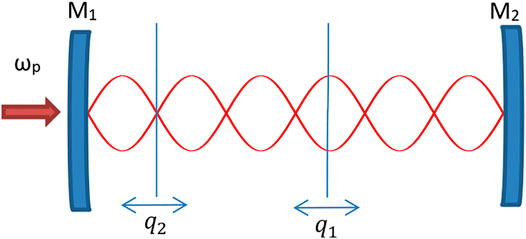
FIGURE 1. Schematic diagram of a Fabry–Pérot optical cavity coupling with two partially transparent dielectric membranes which can be looked as two oscillators. The positions of membranes 1 and 2 in cavity are expressed as
Using the Heisenberg equation of motion, we can establish the evolution equation of the system operators. In addition, the dynamics of the total system also depends on the fluctuating dissipative processes affecting the optical and mechanical modes; that is, the corresponding damping and noise terms are also added to the evolution equation. Finally, the quantum Langevin equations of the system operators can be written as follows:
where
where we only consider the first-order terms in the fluctuations in Eq. 3. Substituting Eq. 3 into Eq. 2, we can obtain the equations satisfied by steady-state mean values
where and stand for the effective optomechanical coupling parameters. In the process of deriving Eq. 4, we assume the power of the incident driving field is large enough, that is, so we may neglect the nonlinear terms such as a† a and a q, and we only retain linear terms in Eq. 4. Comparing the coupling parameters as shown in Eq. 1, the effective optomechanical coupling parameters and become larger. In addition, we introduce the cavity field quadratures and as well as the corresponding quadratures of Hermitian input noise operators and. The existence of the driving field enhances the coupling between the oscillators and the cavity field; that is, the effective optomechanical coupling is helpful to produce significant optomechanical entanglement. Here, we consider the case where the system is in a steady state. We know that once the system enters a unique steady state, it no longer depends on the initial conditions since the quantum noise of the and is a zero mean quantum Gaussian noise, and the dynamics is linearized. In addition, the quantum steady state for the fluctuations can be expressed as a zero mean bipartite Gaussian state, and it is fully characterized by its 6 × 6 correlation matrix, where is the vector of the continuous variable fluctuation operator. Vector of the noise is written as, and the coefficient matrix of Eq. 4 is given by
Equation 4 can be written in a compact form as
When the system reaches a steady state, we can let
Correlation matrix
where subscripts
where
3 Results and Discussions
In this section, we will talk about the properties of the entanglement of the system. Here, values of physical parameters are based on Ref. [21]. Some common parameter values include Planck’s constant
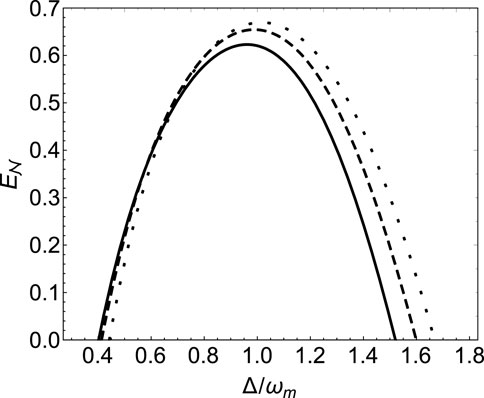
FIGURE 2. Logarithmic negativity
From Figure 2, we know that logarithmic negativity
Next, we show logarithmic negativity
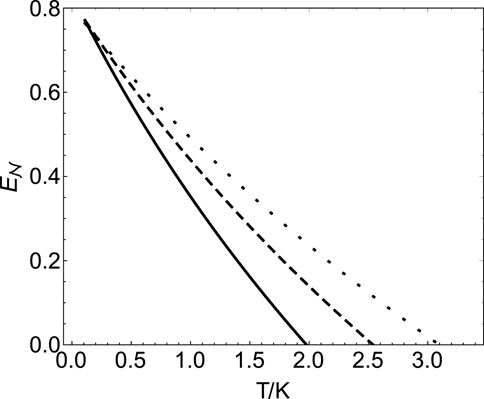
FIGURE 3. Plot of logarithmic negativity
In Figure 4, we plot the three curves that can show that logarithmic negativity
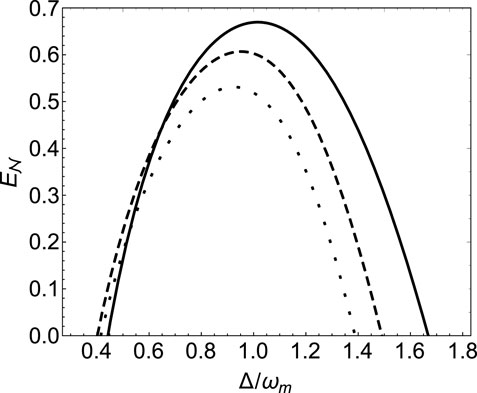
FIGURE 4. Logarithmic negativity
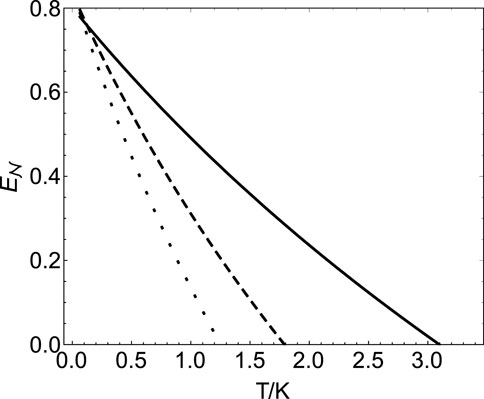
FIGURE 5. Logarithmic negativity
Finally, we investigate the entanglement between the oscillator and cavity mode. By calculating the correlation matrix, we can obtain the logarithmic negativity
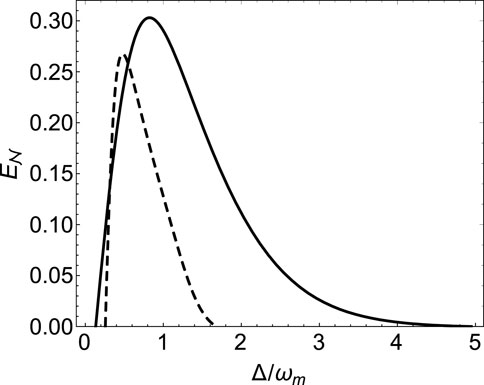
FIGURE 6. Logarithmic negativity
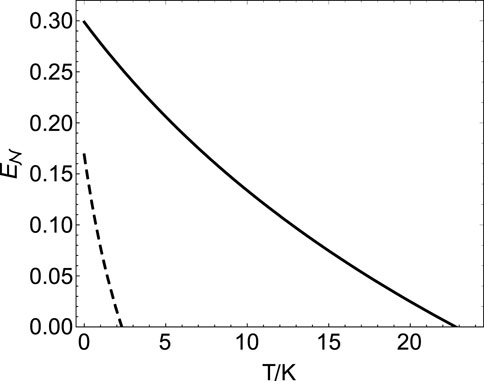
FIGURE 7. Logarithmic negativity
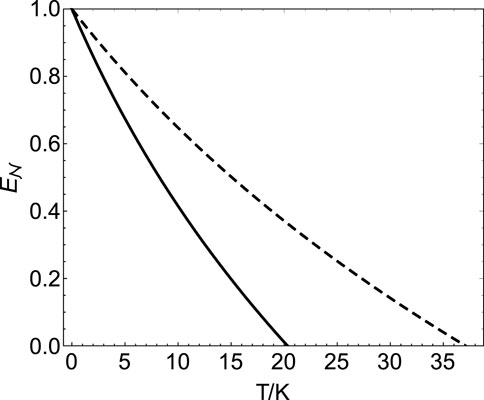
FIGURE 8. Logarithmic negativity
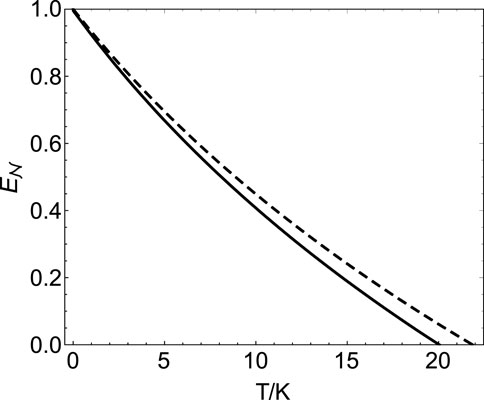
FIGURE 9. Logarithmic negativity
4 Conclusion
In summary, we have proposed to investigate the properties of quantum entanglement of the optomechanical system including two mechanical oscillators, where the two mechanical oscillators are coupled with the cavity field in different coupling modes: the interaction between mechanical oscillator 1 and the cavity field is first-order coupling, and mechanical oscillator 2 and the cavity field has a quadratic coupling. We mainly studied the entanglement between two mechanical oscillators with different coupling modes. The influences of the frequency of the cavity field and the mass of mechanical oscillators on the entanglement between two mechanical oscillators are investigated. We analyze in detail the characteristics of logarithmic negativity
Data Availability Statement
The original contributions presented in the study are included in the article/Supplementary Material; further inquiries can be directed to the corresponding authors.
Author Contributions
AC and TY conceived the physical model and the idea of the study, and YL and LD carried out the calculation and numerical analysis. YL and AC supervised the work. All authors contributed to the interpretation of the work and the preparation of the manuscript.
Funding
This study was funded by the National Natural Science Foundation of China (12005189, 12175199, and 12075209) and the Natural Science Foundation of Zhejiang Province (LZ20A040002).
Conflict of Interest
The authors declare that the research was conducted in the absence of any commercial or financial relationships that could be construed as a potential conflict of interest.
Publisher’s Note
All claims expressed in this article are solely those of the authors and do not necessarily represent those of their affiliated organizations, or those of the publisher, the editors, and the reviewers. Any product that may be evaluated in this article, or claim that may be made by its manufacturer, is not guaranteed or endorsed by the publisher.
References
1. Deb RN. Quantum Entanglement in Multiparticle Systems of Two-Level Atoms. Phys Rev A (2011) 84:032327. doi:10.1103/PhysRevA.84.032327
2. Mirkhalaf SS, Smerzi A. Entanglement Detection in a Coupled Atom-Field System via Quantum Fisher Information. Phys Rev A (2017) 95:022302. doi:10.1103/PhysRevA.95.022302
3. Yang W-X, Zhan Z-M, Li J-H. Efficient Scheme for Multipartite Entanglement and Quantum Information Processing with Trapped Ions. Phys Rev A (2005) 72:062108. doi:10.1103/PhysRevA.72.062108
4. Bittencourt VASV, Bernardini AE, Blasone M. Quantum Transitions and Quantum Entanglement from Dirac-like Dynamics Simulated by Trapped Ions. Phys Rev A (2016) 93:053823. doi:10.1103/PhysRevA.93.053823
5. Osawa S, Simon DS, Malinovsky VS, Sergienko AV. Controllable Entangled-State Distribution in a Dual-Rail Reconfigurable Optical Network. Phys Rev A (2021) 104:012617. doi:10.1103/PhysRevA.104.012617
6. Wei H, Deng Z, Zhang X, Feng M. Transfer and Teleportation of Quantum States Encoded in Decoherence-free Subspace. Phys Rev A (2007) 76:054304. doi:10.1103/PhysRevA.76.054304
7. Laurenza R, Lupo C, Lloyd S, Pirandola S. Dense Coding Capacity of a Quantum Channel. Phys Rev Res (2020) 2:023023. doi:10.1103/PhysRevResearch.2.023023
8. Ra Y-S, Lim H-T, Kim Y-H. Remote Preparation of Three-Photon Entangled States via Single-Photon Measurement. Phys Rev A (2016) 94:042329. doi:10.1103/PhysRevA.94.042329
9. Morachis Galindo D, Maytorena JA. Entangling Power of Symmetric Two-Qubit Quantum Gates and Three-Level Operations. Phys Rev A (2022) 105:012601. doi:10.1103/PhysRevA.105.012601
10. Cavalcanti D, Guerini L, Rabelo R, Skrzypczyk P. General Method for Constructing Local Hidden Variable Models for Entangled Quantum States. Phys Rev Lett (2016) 117:190401. doi:10.1103/PhysRevLett.117.190401
11. Shi F, Ye Z, Chen L, Zhang X. Strong Quantum Nonlocality in N-Partite Systems. Phys Rev A (2022) 105:022209. doi:10.1103/PhysRevA.105.022209
12. Aspelmeyer M, Kippenberg TJ, Marquardt F. Cavity Optomechanics. Rev Mod Phys (2014) 86:1391–452. doi:10.1103/RevModPhys.86.1391
13. Liu J, Zhou Y-H, Huang J, Huang J-F, Liao J-Q. Quantum Simulation of a Three-Mode Optomechanical System Based on the Fredkin-type Interaction. Phys Rev A (2021) 104:053715. doi:10.1103/PhysRevA.104.053715
14. Deng ZJ, Yan X-B, Wang Y-D, Wu C-W. Optimizing the Output-Photon Entanglement in Multimode Optomechanical Systems. Phys Rev A (2016) 93:033842. doi:10.1103/PhysRevA.93.033842
15. Huang S, Chen A. Mechanical Squeezing in a Dissipative Optomechanical System with Two Driving Tones. Phys Rev A (2021) 103:023501. doi:10.1103/PhysRevA.103.023501
16. Sala K, Doicin T, Armour AD, Tufarelli T. Quantum Estimation of Coupling Strengths in Driven-Dissipative Optomechanics. Phys Rev A (2021) 104:033508. doi:10.1103/PhysRevA.104.033508
17. Zhou L, Cheng J, Han Y, Zhang W. Nonlinearity Enhancement in Optomechanical Systems. Phys Rev A (2013) 88:063854. doi:10.1103/PhysRevA.88.063854
18. Zhou B-y., Li G-x. Ground-state Cooling of a Nanomechanical Resonator via Single-Polariton Optomechanics in a Coupled Quantum-Dot-Cavity System. Phys Rev A (2016) 94:033809. doi:10.1103/PhysRevA.94.033809
19. Huang S, Agarwal GS. Electromagnetically Induced Transparency with Quantized Fields in Optocavity Mechanics. Phys Rev A (2011) 83:043826. doi:10.1103/PhysRevA.83.043826
20. Sete EA, Eleuch H. Controllable Nonlinear Effects in an Optomechanical Resonator Containing a Quantum Well. Phys Rev A (2012) 85:043824. doi:10.1103/PhysRevA.85.043824
21. Vitali D, Gigan S, Ferreira A, Böhm HR, Tombesi P, Guerreiro A, et al. Optomechanical Entanglement between a Movable Mirror and a Cavity Field. Phys Rev Lett (2007) 98:030405. doi:10.1103/PhysRevLett.98.030405
22. Vitali D, Tombesi P, Woolley MJ, Doherty AC, Milburn GJ. Entangling a Nanomechanical Resonator and a Superconducting Microwave Cavity. Phys Rev A (2007) 76:042336. doi:10.1103/PhysRevA.76.042336
23. Genes C, Vitali D, Tombesi P. Emergence of Atom-Light-Mirror Entanglement inside an Optical Cavity. Phys Rev A (2008) 77:050307R. doi:10.1103/PhysRevA.77.050307
24. Riedinger R, Wallucks A, Marinković I, Löschnauer C, Aspelmeyer M, Hong S, et al. Remote Quantum Entanglement between Two Micromechanical Oscillators. Nature (2018) 556:473–7. doi:10.1038/s41586-018-0036-z
25. Bhattacharya M, Uys H, Meystre P. Optomechanical Trapping and Cooling of Partially Reflective Mirrors. Phys Rev A (2008) 77:033819. doi:10.1103/PhysRevA.77.033819
26. Plenio MB. Logarithmic Negativity: a Full Entanglement Monotone that Is Not Convex. Phys Rev Lett (2005) 95:090503. doi:10.1103/PhysRevLett.95.090503
27. Vidal G, Werner RF. Computable Measure of Entanglement. Phys Rev A (2002) 65:032314. doi:10.1103/PhysRevA.65.032314
28. Kleckner D, Marshall W, de Dood MJA, Dinyari KN, Pors B-J, Irvine WTM, et al. High Finesse Opto-Mechanical Cavity with a Movable Thirty-Micron-Size Mirror. Phys Rev Lett (2006) 96:173901. doi:10.1103/PhysRevLett.96.173901
Keywords: optomechanical system, entanglement, mechanical oscillator, dual-coupling, nonlinear effect
Citation: Li Y, Deng L, Yin T and Chen A (2022) Entanglement Between Two Mechanical Oscillators in a Dual-Coupling Optomechanical System. Front. Phys. 10:908205. doi: 10.3389/fphy.2022.908205
Received: 30 March 2022; Accepted: 02 May 2022;
Published: 15 June 2022.
Edited by:
Zhi Jiao Deng, National University of Defense Technology, ChinaReviewed by:
Xing Xiao, Gannan Normal University, ChinaZhanjun Zhang, Zhejiang Gongshang University, China
Copyright © 2022 Li, Deng, Yin and Chen. This is an open-access article distributed under the terms of the Creative Commons Attribution License (CC BY). The use, distribution or reproduction in other forums is permitted, provided the original author(s) and the copyright owner(s) are credited and that the original publication in this journal is cited, in accordance with accepted academic practice. No use, distribution or reproduction is permitted which does not comply with these terms.
*Correspondence: Li Deng, lideng75@zstu.edu.cn; Aixi Chen, aixichen@zstu.edu.cn
 Yujie Li1
Yujie Li1 Aixi Chen
Aixi Chen